10 Creative Ways To Use Tangerine Peels

All citrus fruits are stars in our eyes, but the humble tangerine, in particular, has a lot going on beneath its bright, bumpy surface. Most of us see the peel as a barrier, or something to dispose of as quickly as possible. But every time you discard those peels, never to be seen again, you're saying goodbye to one of nature's most versatile and flavorful ingredients. A little creativity is all it takes to turn the forgettable tangerine peel into your kitchen's most useful secret weapon.
Much like bread crust and broccoli stems, tangerine peels are as unglamorous as they are nutritious. Chock-full of important vitamins and nutrients, the peels contain everything from fragrant oils to antioxidant-packed pith to flavor-enhancing zest. Classic recipes and cooking processes can be upgraded or made simpler thanks to this unexpected hero of the fruit bowl. With a little patience and creativity, you really can make the most of the entire tangerine, peel and all.
Read more: 13 Simple Tricks To Pick The Best Fresh Fruit Every Time
Rejuvenize Herbal Tea With Tangerine Peels

A steaming mug of herbal tea is not unlike a warm hug -- comforting and rejuvenating, not to mention soothing. Even better, herbal tea can have nutritional benefits, especially if you customize your brew with dried or dehydrated tangerine peels.
Whole tangerines are an excellent source of vitamins C and A, but the peels are just as nutritious and vitamin-rich. Even more importantly, tangerine peels contain antioxidants that bring the healing properties of your herbal tea to new levels. Per a study published in the International Journal of Molecular Sciences, one of the antioxidants in the peel, nobiletin, may decrease the severity of memory loss in those with Alzheimer's or Parkinson's. The peel is also packed with oils, and it's those oils that emit the lovely citrus scent that's reproduced in candles and shampoo. The sweet yet tangy scent is only half as delicious as the flavor that the dried tangerine peels add to the herbal tea.
To add the peels to your tea, you should start by thoroughly cleansing the peels and scraping away the pith. You could dry the peels in the sun for a week after, which is the traditional way of going about it. But a safer and faster option is to simply place the peels into an oven or food dehydrator. The longer the peel is in the oven, the crispier it will become. Simply plunk the dried peels into your fresh brew for a unique, warming flavor.
Deepen Flavors In Sauces, Dressings, And Glazes With Tangerines

If your summertime vinaigrette or holiday ham glaze is missing an x-factor, you may need an ace up your sleeve ... or more accurately, a tangerine in your fruit bowl. Making citrus the main star works well with desserts, but when it comes to savory dishes, a squeeze of tangerine or zest from the peel should make a subtle cameo. There's no better way to do this than by adding citrus to sauces, dressings, and glazes. Since all three are usually used to enhance the main dish, adding citrus in the form of pureed peels or tangerine zest can go a long way to making the entire dish have a fuller, deeper flavor profile.
Tangerine zest, which you get from lightly grating the peel, adds a welcomed brightness to this tangerine brown butter vinaigrette recipe. And yes, merely sprinkling tangerine zest into a vinaigrette can greatly impact the dressing's overall flavor. Thanks to the oils in the peel, tangerine zest has an incredibly strong flavor and scent. You can take zesting a step further by heavily grating a tangerine peel and a lemon peel to give the glazed carrots in this recipe an autumnal flair. Tangerine peels are a common ingredient in Asian cuisine; neglecting to season your soy sauce with tangerine zest would be a wasted opportunity. Doing so helps offset the saltiness while giving the sauce a Sichuan-style twist.
Use This Chef-Approved Method To Upgrading Pumpkin Pie

When celebrity chefs reveal their secrets to the best pumpkin pie, we listen. We'd like to shake cookbook author Gale Gand's hand in particular for her contributions to pumpkin pie. Without her, we never would've thought of adding citrus to pumpkin pie, although now that we think about it, the two flavors make perfect sense together. The bitter and sweet flavor of a tangerine peel pairs amazingly with the earthiness of pumpkin pie. Since Gand's recipe revolves around the autumnal pumpkin flavor, the added citrus of the tangerine peel should merely enhance the main flavor, not become the main event.
That said, Gand's recipe calls for zest from four entire tangerines. It may sound like an overload of citrus, but the pumpkin is so overpowering that the tangerine zest actually helps diversify the taste. This creates a satisfying balance of flavors that makes every mouthful of pumpkin pie feel just as fresh as the first bite. Just when you think the classic pumpkin pie flavoring will send you into a Thanksgiving day coma, bam! The brightening tangerine zest wakes you right up. Best of all, pumpkin isn't the only orange vegetable that pairs well with citrus. Tangerine and carrots also go together surprisingly well, and adding a little tangerine zest to carrot cake batter is just one way you can put a twist on another classic flavor.
Add A Citrusy Twist To Cocktails

Popping a twist of orange into a cocktail is nothing new, and it's a classic fresh garnish in whiskey cocktails for a reason: Orange peels add spark and freshness to otherwise one-note cocktails. But if you want to knock the socks off of a seasoned whiskey drinker, sneakily add a twist of tangerine peel to the alcohol. The tangerine is like the orange's weird, artsy cousin: it tastes similar but with a stronger, more powerful kick. Even though tangerines are related to the average orange, the oils in their respective peels have a slightly different scent and flavor. A twist can moderately change the overall taste of a cocktail.
The stronger flavor yet shorter aftertaste of tangerines make their peels ideal for cocktails, as the tangerine twist should lightly infuse the alcohol, not overpower it. As always, the tangerine peel should complement the dish or cocktail, not take over. It's also important to consider the strength of a tangerine's aroma, which can be stronger than that of an ordinary orange. The sweet scent alone is refreshing and can put a summery twist on an ordinary cocktail. The mandarin mojito, for example, is one of the best citrus cocktails that swaps out the classic lime for a tangerine, which offers a warmer, sweeter taste.
Bring Unexpected Tanginess To Beef
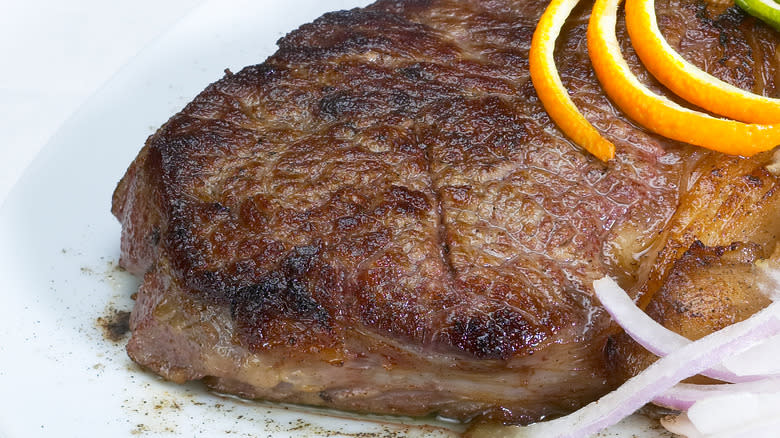
Tangerines and citrus flavor profiles, in general, pair well with strong, salty flavors, which is why it's so often an ingredient in Asian cuisine. While most beef recipes don't ask for crispy, dried tangerine peels, you can include them if you want. The peel's light citrus profile counteracts the heaviness of the beef, making for a well-balanced dish even picky eaters can enjoy. Most people simply peel the skin off a tangerine, cut it into thin strips, and then cook it on the stove alongside the beef and other ingredients. A splash or two of tangerine juice heightens the tangy notes.
You can put your own spin on tangerine beef with this recipe for tangerine sticky ribs. Tangerine zest not only makes a barbecue-charred rack of ribs look even more appetizing but gives them a refreshing and unexpected citrusy kick. Take another page out of the ultimate Chinese cookbook by smoking pork or fish with a unique combination of tea leaves, wood shavings, and tangerine peels. These unexpected ingredients infuse the meat with a perfect balance of earthiness and sweetness. And, of course, the added smokiness pulls the whole meat dish together.
Candied Tangerine Peels Make A Delicious Snack
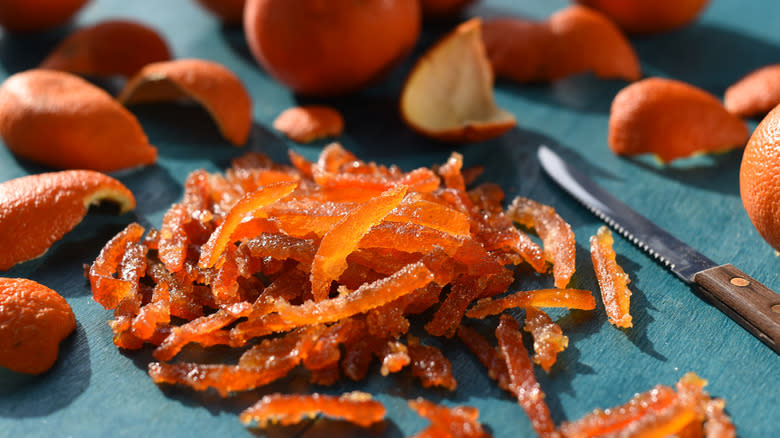
Lots of fruits have been called nature's candy, but tangerines are especially deserving of the title. They're easy to peel and separate, and even easier to eat. The only downside is the tangerine peelings that usually litter the floor in the aftermath. The peels are lovely and aromatic but tough to eat, what with their pulpy, pithy skins. There's a delicious solution to this problem. This recipe for candied orange or tangerine peels can satisfy any sweet tooth while ensuring that every part of the tangerine is enjoyed, skin and all.
For candied tangerine peels, you should peel the outer skin before you eat the fruit. This ensures that the peels have a consistent shape and texture. The peels need to be boiled and then dropped into a simmering mixture of sugar and water. This sugar water mixture will cover the peels in a syrup or caramel-like coating. You should repeat the simmering process until the peels have lost their bitterness and achieved a soft, chewy consistency. Feel free to eat the candied tangerine peels as-is, but you can also use candied fruit peels in brownies for a fun twist on a classic recipe.
Citrus Marmalade Transforms Toast
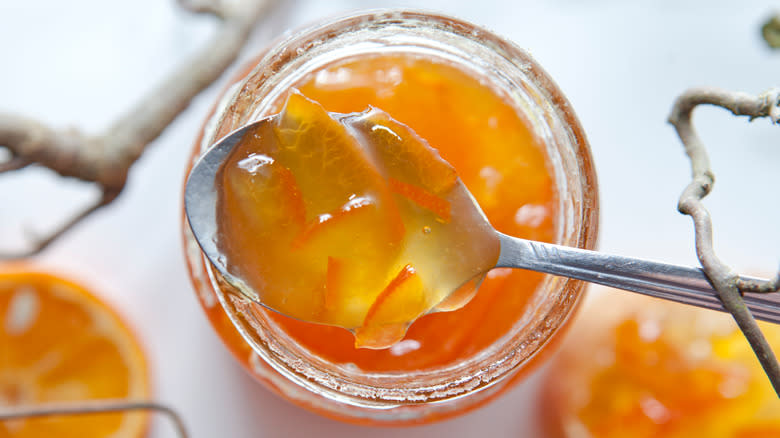
Navel and mandarin oranges are so yesterday. You can make marmalade with much more unique orange varieties. Put a contemporary twist on the classic toast topping using a tangerine instead. Making marmalade out of a tangerine puts every part of the fruit to good use, from the pulp to the pith to the peel. It can be tempting to rid the tangerine of its white, stringy pith, but the pith is instrumental in achieving the thickness and consistency we've come to expect with marmalade. Pith contains pectin, a carbohydrate that prevents marmalade from getting too thin and runny. The pith and inside skin also contain the necessary bitterness that marmalade is known for.
In addition to tangerine, you can add wholesome spices like cinnamon and cardamom to marmalade for an extra kick. And yes, it shouldn't come as a surprise that even tangerine marmalade can be mixed with brandy or whiskey. By the time you've finished making your homemade tangerine marmalade, it may look too delicious to be spread over an ordinary piece of toast. In this case, consider turning your marmalade into a unique dressing or glaze. Best-selling author Martha Stewart recommends spreading the mixture between cake layers for an unexpected kick of citrus.
Add Tangerine As A Zest To Canned Foods
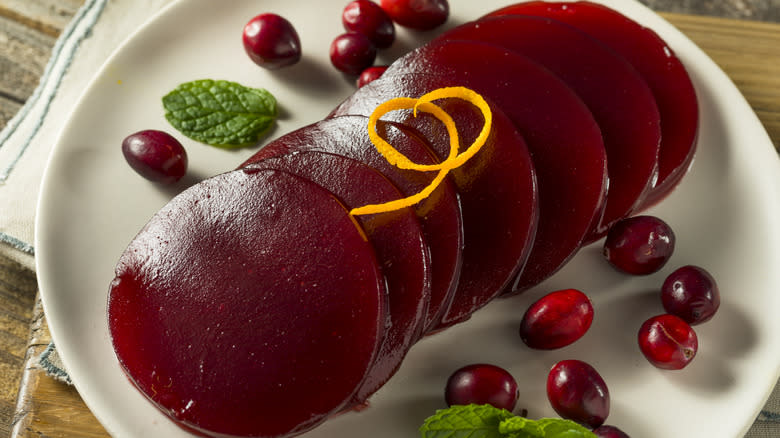
Never underestimate the power of a well-placed zest, peel, or twist. Citrus really should be every chef's secret weapon. The flavoring is powerful in small amounts, enhances complexity and depth, and can even make canned meals your family's new favorite. From canned vegetables and legumes to cranberry sauce, you can elevate ordinary dishes with only a few tangerine peels. For example, you can add citrus to canned cranberry sauce to put a fun, festive spin on a traditional recipe. Tangerines provide a burst of energy to canned cranberry sauce, whether you add tangerine zest or layer the slices of jellied cranberry sauce with tangerine wedges or pretty peel twists.
Even an average can of dried beans can become deliciously complex with the addition of citrus peels. Since the oil in tangerine peels can infuse other foods with its pleasant fragrance, there's no reason why it can't make dried beans taste even better. Simmer dried beans of any variety alongside tangerine peels so that the oils mingle with the beans. Beans are so versatile that this method can improve the flavors of any number of dishes, from burritos to grain bowls to stews. Best of all, adding tangerine peels to your canned beans is as simple as peeling, pouring, and simmering.
Can Tangerines For Future Use
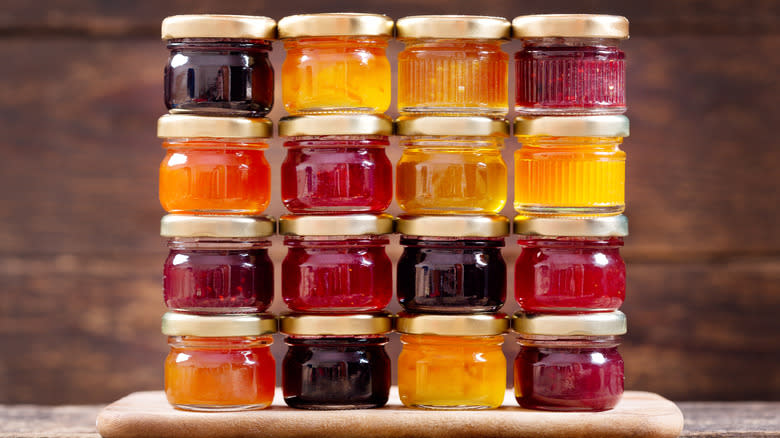
It may sound old-fashioned, but consider canning tangerines for future use. With the way grocery prices have increased recently, canning fruits just may be the old-school yet resourceful tradition we need in order to save money. Canning is a sustainable and enjoyable alternative to simply tossing ripe fruit into the trash. Luckily, it's easier than your grandmother may have made it seem. If you associate canned preserves with soft fruits like peaches and pears, just know the method can also work with oranges, grapefruit, and, yes, tangerines.
There are, however, certain types of oranges better suited to the canning process than others. If you only have large navel oranges on hand, you'll have to separate the orange slices as opposed to canning the fruit whole, which could get tiresome. Clementines and tangerines, which are usually on the smaller end of the orange-size spectrum, can be canned whole. Just remember to add the peels to the cans. We want the oils from the peels to make the canned tangerine mixture all the more potent and delectable when you open it up again in a few weeks or months. Also, it's important to remember that some oranges are more acidic than others, and homemade canning works best with citrus that has a pH level of around or below 4.6. If the pH is too high, the canned mixture runs the risk of growing bacteria.
Give Your Water A Tangerine-Infused Kick

Like most people, we're always looking for fresh ingredients to make drinking water more exciting or at least more enjoyable. Tangerine-infused water is an energizing alternative to the tangerine-less version, and making it is as simple as it gets: Obtain tangerine, peel tangerine, eat tangerine, drop tangerine peels into water glass, and voila! The oil in tangerine peels is endlessly useful, and it can even infuse regular drinking water with its bright, sweet flavoring and enticing aroma. These oils are why citrus fruit peels are particularly good at flavoring liquids, from water to salad dressing to whiskey.
You could use tangerine zest or even tangerine slices to flavor your water, but those oils in the peel are what get the flavoring job done. There are some precautions you should take when using raw produce or peels to flavor your water, however. All raw produce runs the risk of molding or growing bacteria when improperly stored, and that includes fruit-infused water. Keep your bottle of infused water in a cool, sealed container. According to Michigan State University, it should always be refrigerated after two hours, and leftover infused water should only be in the fridge for up to six days. If you keep these precautions in mind, then there's no reason why you can't be greeted with a bang of tangerine when you take a swig from your water bottle.
Static Media owns and operates Tasting Table, The Daily Meal, and Food Republic.
Read the original article on Tasting Table.

